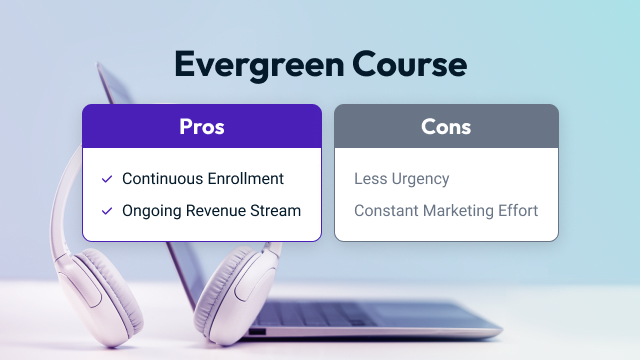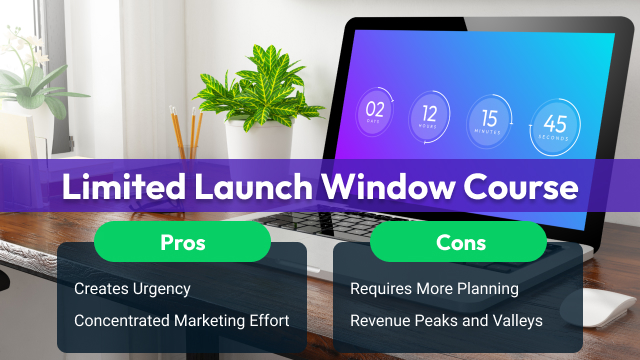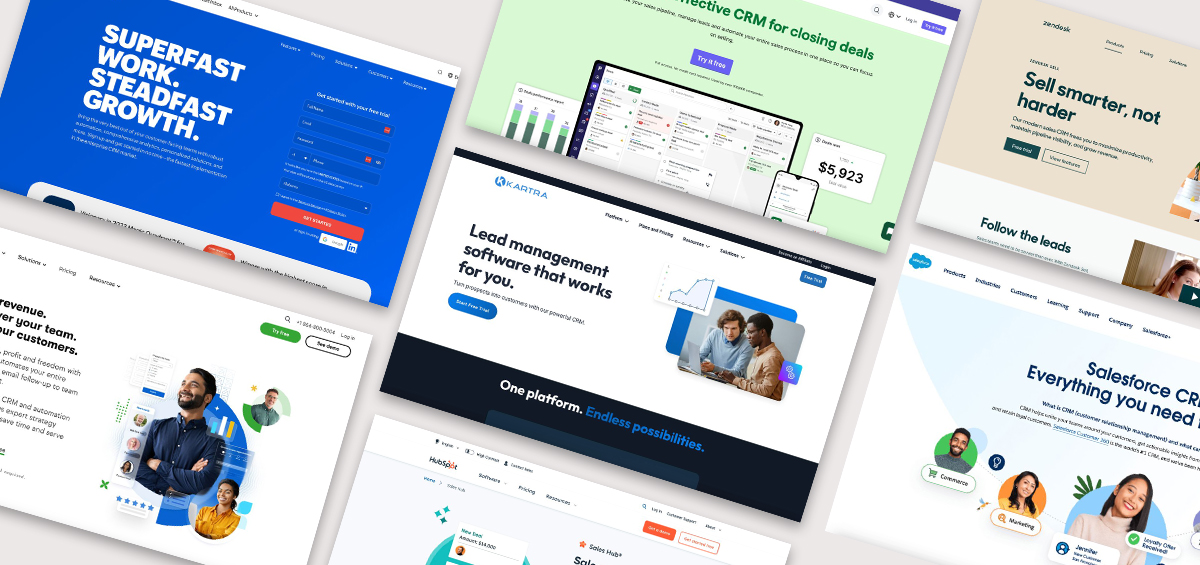Becoming an online course creator is a fantastic way to share your expertise and generate significant income. But you can have the best course in the world and still get zero students. The key is knowing how to launch your course correctly in order to generate the most revenue.
It all comes down to strategic planning and execution.
Without a well-thought-out launch strategy, even the most valuable course content might not reach its full revenue potential. This guide will walk you through the essential steps to maximize your revenue by launching your first online course in a strategic way.
Let’s go in depth into our online course launch checklist for the essential steps to ensure your online course creation efforts not only reach your target audience but also maximize your earning potential from day one.
Choose Your Course Launch Strategy: Evergreen or Limited Launch Window?
When it comes to launching an online course for the first time, you have two main options: an evergreen model or a limited launch window. Each approach has its own advantages and disadvantages for your new course, and choosing the right one depends on your goals and resources.

Evergreen Course: The Benefits
Continuous Enrollment
With an evergreen course, students can enroll at any time. This means your course is always open for business, allowing you to reach new students continuously.
Ongoing Revenue Stream
An online learning evergreen course provides a steady source of income. Since there’s no fixed enrollment period on your sales page, you can consistently generate revenue throughout the year.
Evergreen Course: The Downsides
Less Urgency
Because students can join anytime, there’s no sense of urgency to enroll. This can lead to slower sign-ups compared to time-limited offers.
Constant Marketing Effort
To keep attracting new students, you need to engage in ongoing marketing efforts. This requires a continuous investment of time and resources to maintain visibility and interest.

Limited Launch Window: The Benefits
Creates Urgency
A limited launch window creates a sense of urgency and scarcity, encouraging potential students to enroll quickly before the opportunity closes.
Concentrated Marketing Effort
With a set launch period, you can focus your marketing efforts into a shorter time frame, creating a big impact with a concentrated push.
Limited Launch Window: The Downsides
Requires More Planning
A successful limited launch requires a good amount of planning and coordination. Every detail, from marketing materials to webinar schedules, needs to be planned well in advance.
Revenue Peaks and Valleys
Unlike the steady income of an evergreen course, a limited launch window can lead to significant revenue peaks during launch periods followed by valleys when the course is closed to new students.
So there you have it. Both options have their pros and cons. Be sure to consider your course idea, resources, audience, and long-term goals. Those variables might be enough to decide which approach aligns best with your business strategy.
Pre-Launch Strategies
You can do a lot to prepare for a successful online course launch. Building anticipation and effectively using marketing channels can significantly boost your course’s visibility and enrollment rates even before your course goes live.
Imagine your “pre-launch” as “pre-selling” your course. You’re demonstrating just how valuable it will be for someone when they buy it. Stack your sales funnel with people who can’t wait to give you money!
1. Build Anticipation
Engage Your Existing Email List
Start by warming up your existing email list. Send out an email sequence of launch emails that provide valuable content related to your course topic, teasing what’s to come. This keeps your audience engaged and excited well ahead of your launch day.
Don’t have an email list yet for an email campaign? Here’s your step by step guide to get started with email marketing.
Create Teaser Content on Social Media
Share sneak peeks and behind-the-scenes content about your course on your social media platforms. How you developed the content, how you recorded the lessons, and a list of your lessons are all ideas that have a flair of mystery to them.
You could also post a “mini course” lesson that provides a quick win for your audience that convinces them to buy your course for more valuable lessons. You could even share an entire module from your course to provide more value. That develops curiosity about what other lessons you’ll teach and gives a flavor of the learning experience they’ll have within the course.
Run Countdowns and Sneak Peeks
There’s a reason why in cartoons the dastardly villain adds a ticking alarm clock onto the cartoon bomb. It’s much more dramatic when you know there is only a limited amount of time left before something big happens.
Your online course launch is lower stakes than defusing an explosive, but the idea still applies. Incorporate countdowns onto your online course landing page and social media accounts to build excitement as the launch date approaches.

2. Utilize Affiliate Marketing
Recruit Affiliates and Set Up an Affiliate Program
Reach out to influencers and partners in your niche who can promote your course as affiliates. Affiliates are a great way to grow revenue without an upfront cost. They get paid a commission off your course sale, but only when they help sell a course. The more attractive your commissions, the more incentive for affiliates to sell.
Here are more referral marketing strategies for your growth marketing plan.
Provide Affiliates with Marketing Materials and Incentives
It’s easier for affiliates to promote your course when they have great assets to share.
Equip your affiliates with all the necessary marketing materials, such as banners, email templates, and social media posts. Offer additional incentives, like bonuses for top performers, to motivate them further.
Track Affiliate Performance and Sales
Use tracking tools to monitor the performance of your affiliates. Keep an eye on their sales and provide feedback and support to help them improve their efforts.
3. Leverage Social Media
Identify the Right Platforms for Your Audience
There are so many different social media outlets, and you only have so much time in your day. Determine which social media platforms your target audience uses the most. Then focus your efforts on these platforms to maximize your reach and engagement.
Plan and Schedule Posts to Build Anticipation
Create a content calendar to plan and schedule your posts leading up to the launch. Consistent posting helps maintain momentum and keeps your audience engaged. Plus, scheduling all at once frees up your future weeks to focus on other aspects of your launch.
Use Live Videos and Stories to Engage Followers
Leverage live videos and stories to interact with your audience in real-time. This creates a sense of community and allows you to address questions and build excitement directly.
Launch Day Strategies
Your Launch Day is finally here! Now is the time to maintain momentum and capitalize on all the anticipation you’ve built. Coordinating your efforts across different channels on the big day can exponentially improve your success.
1. Maximize Impact on Social Media
Coordinate a Social Media Blitz Across Platforms
Simultaneously post across all your social media channels to create a big splash. This coordinated effort ensures maximum visibility and engagement at the peak time you want.
Engage with Your Audience in Real-Time
Respond to comments, messages, and questions promptly. Real-time engagement shows that you’re active and invested in your audience’s experience.
Use Hashtags and Tag Influencers
Use relevant hashtags to reach a broader audience. Tagging influencers who support your course can also help amplify your message.

2. Host a Launch Webinar
Increase Your Engagement and Sales
Most likely your online course has you on camera. Why not give your audience a taste of what they can expect from your course by leading a live webinar?
Webinars provide a direct way to connect with your audience, answer their questions, and showcase the value of your course. They can significantly boost engagement and conversions by providing that “personal touch.” To keep your webinar laser focused, you could cover one key pain point that your course helps alleviate.
Wondering what steps to take so your webinar is successful? Here’s how to create a webinar your audience will love.
Plan Your Webinar Content and Promotion
The more value you can provide with your webinar, the better attendance and online course sales you’ll get. Prepare a structured and value-packed webinar to lock in a great result.
Promoting your webinar heavily through your email list, social media, and affiliates can help ensure maximum attendance, too.
Offer Exclusive Bonuses for Webinar Attendees
People love feeling special, so make them feel like VIPs if they attend!
Incentivize attendees by offering exclusive bonuses to those who join the webinar. This could be a special discount, additional resources, or early access to the course.
3. Activate Your Affiliate Network
Coordinate Launch Day Activities with Affiliates
Make sure your affiliates are prepared and know their roles on launch day. Provide them with any last-minute materials and instructions to maximize their promotional efforts.
Provide Real-Time Support and Updates
Stay in touch with your affiliates throughout the day to provide support and updates. Address any issues quickly to maintain a smooth operation.
Monitor Affiliate-Driven Traffic and Sales
Use analytics tools to track the traffic and sales generated by your affiliates. This helps you understand what’s working and where to focus your efforts for the rest of the launch period.
Post-Launch Strategies
Launch Day is just that – one day. You have so many other days after that one where you can make sales.Once your course is live, it’s essential to keep the momentum going. Post-launch strategies help you analyze performance, maintain engagement, and maximize long-term revenue.

1. Analyze Launch Performance
Track Key Metrics: Sales, Conversion Rates, Traffic Sources
Monitor your sales, conversion rates, and traffic sources to understand how well your launch performed. Use tools like Google Analytics and your course platform’s analytics to gather this data.
Gather Feedback from Students and Affiliates
Collect feedback from your students and affiliates to get a sense of if your course helped solve a problem (for your students) and if there were any issues in promoting the course (for your affiliates). Sending out surveys or conducting interviews are great ways to get both broad and granular with feedback.
Use Data to Refine Future Launches
Analyze the data and feedback to identify areas for improvement. Use these insights to refine your strategies for future launches, ensuring each one is more successful than the last.
2. Continuous Engagement
Nurture Your Email List with Ongoing Content
Keep your email list engaged by regularly sending valuable content. Share tips, updates, and exclusive offers to maintain interest and foster a loyal community.
Encourage Student Testimonials and Reviews
Ask your students to share their experiences and leave reviews. Positive testimonials can be powerful marketing tools for attracting new students.
Run Limited-Time Promotions to Boost Sales
Periodically offer limited-time promotions to create urgency and drive additional sales. This can help you maintain a steady revenue stream even after the initial launch period.
3. Join Online Communities for Further Promotion
Find Relevant Groups/Forums/Communities and Provide Value
Identify online communities where your target audience spends time. Participate actively by providing value and establishing yourself as an expert in your field.
Subtly Promote Your Course Without Being Spammy
Promote your course in a subtle way by sharing useful content and mentioning your course where it feels relevant. Avoid coming across as overly promotional to maintain credibility – being “salesly” doesn’t do well in online communities.
Host FAQ Sessions and Discussions
Host FAQ sessions and discussions in these communities to engage with potential students directly. This builds trust and showcases your expertise.
Create Your Own Facebook Group for Course Members
Create a dedicated Facebook group for your course members. You help foster a sense of community when you provide a space to interact, ask questions, and share progress.

Conclusion
The launch process of an online course involves careful planning and execution. From choosing the right launch model and building anticipation to leveraging social media and analyzing performance, each step is crucial for your online business success.
If you get it right, you can create an income stream with huge revenue potential. And a sustainable online course business is about as close to passive income as you’ll see online.
We all have to start somewhere. And the best part about launching your first course is you’ll be even more prepared for launching your next course.Ready to launch your online course and maximize your revenue?
Get started with Kartra today and access all the tools you need to create, market, and sell your course effectively.


